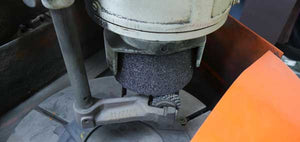Use these tips to get better results, longer stone life and lower-cost flywheel grinding.
1) Match the stone to the material.
Most American automotive flywheels are cast iron. Most truck, bus and agricultural flywheels are cast steel. High-performance and a few import flywheels are billet steel. To determine what material your flywheel is made of (hardness), “spark test” a flywheel before grinding it. Using whatever grinding stone is on the machine, briefly touch it to the flywheel and watch the sparks.
- Cast Iron (soft) flywheels make deep orange sparks that travel only a short distance before burning up.
- Cast Steel (medium) flywheels make light orange to golden sparks that travel farther before burning up.
- Billet Steel (very hard) flywheels make bright yellow-white sparks that travel very far before burning up.
A shop supply company should be able to deliver a complete selection of grinding stones for these different types of flywheel metallurgy. For most cast iron flywheels, we recommend a general purpose stone that is made of silicon carbide (generally dark gray or black in color). For harder flywheels like steel,we recommend using a stone that is made of aluminum oxide (generally white or ruby in color).
2) Change the amount of grinding pressure.
You can affect the way a stone grinds different materials by simply changing the amount of pressure you exert during the grinding process. If the stone is too soft, reduce the grinding pressure. If your stone is too hard increase the grinding pressure. Although this will reduce your inventory of grinding stones, it is better to have the correct stone for the material you are grinding.

3) Properly dress the stone.
After you have selected the correct flywheel stone for the application, it is important to apply a proper dress to the grinding surface. Some flywheel grinders are supplied with a star-type dresser and others have a diamond-type dresser. Before dressing, always make sure the stone is properly mounted and wear eye protection. If you have a star-type dresser, bring it in close to the stone, just below the surface. Turn on the machine and slowly make contact by bringing the star up. Then traverse the star under the stone at a pace similar to the method used for dressing a valve refacer wheel. If you traverse too slowly, you will close the grains of the stone and this will cause premature loading. It is preferred to have a fast traverse to open the grains and allow the stone to be as free-cutting as possible. This will also reduce the time it takes to grind the flywheel. Machines equipped with a diamond-type dresser are even more finicky. Again, it’s important not to “crash” the diamond into the stone. Traverse at a fast pace to open the grains and allow the stone to be as free-cutting as possible.
4) Mix your coolant accurately.
Coolant does more than keep the workpiece cool during the grinding operation. It also carries away the grit and material from the surface.
Proper coolant mixing ratios are critical! Too much coolant will cause the wheel to load up. Too little coolant will allow your flywheel to get hot and might possibly start a rusting process in the reservoir of the machine. Always follow the coolant manufacturer's recommended mixing ratios for the ultimate performance of your coolant.

It’s always a good idea to check your coolant concentration levels with a refractometer to ensure the proper ratio is there. Water evaporates, so you will have to add more water to your coolant from time to time.
Keep the coolant clean. Use a sludge bag and remove the sludge build-up from the sump every few days. Use a deburring stick to remove any rust or burrs from the surface of the flywheel grinder table. (If the flywheel does not sit parallel on the table, it will be ground unevenly.) Also, clean the swarf from the inside of the grinding stone after each job.
It is always a good idea to periodically change the complete reservoir and start fresh. How often depends on how much flywheel grinding your shop is doing. Grinding flywheels is an extremely profitable operation for your shop. It doesn’t require a skilled machinist, it’s fast and the machines don’t take up much floor space (approximately 48″ x 48″). Flywheel Grinders are affordable, too. In just a short period of time, your customers will actually buy the machine for you through the labor dollars it creates.
5) Feed the stone aggressively.
Flywheel grinding is a job that really doesn’t take much time. If you aggressively attack the flywheel with steady down-feed, the typical cast iron flywheel will be ground in about 15 minutes. I don’t recommend that you dial-in a cut and walk away from the machine. This causes heat and premature stone loading. Stay right with the machine and feed about .001 per revolution of the flywheel. This keeps the stone free-cutting and gets the job done. A steady, constant down-feed actually works the stone (meaning the stone “breakdown”) as designed. This unloads the material removed from the flywheel, along with fractured stone grain. If you down-feed properly, you won’t have to dress the stone during the grinding process.
6) Compare prices and dimensions.
Compare the different types of stones that are available. A taller stone has more usable abrasive and should last longer but may not be much higher priced. For instance, many Goodson stones are 2-5/8″ tall with almost 50% more abrasive, yet are priced similar to the 2″ tall stones from other manufacturers.
Final words of advice…
Remember to match the stone to the material you’re grinding, dress the stone properly, mix your coolant accurately and feed the stone aggressively into the workpiece. You should see better results, longer stone life and lower-cost flywheel grinding.


